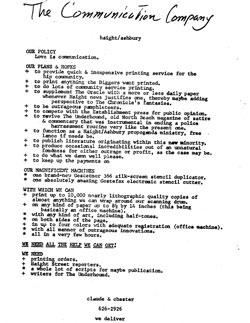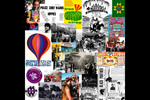The Communication Company
[Member of Underground Press Syndicate]
Publishing Arm of the Diggers
San Francisco's Haight-Ashbury, January to September, 1967
The collective members of the Communication Company fashioned themselves the
publishing arm of the Diggers. As such, their record of broadsides, manifestos,
leaflets and street sheets leaves us a rich slice of Digger philosophy as it played out on
the streets of the Haight-Ashbury during the spring and summer months of 1967. Many of the
anonymous sheets came from the Diggers themselves; others had been penned by Chester
Anderson, one of the Beat survivors from North Beach who gravitated to the new scene in
the Haight. Inspired by the Diggers and their Free philosophy, Chester and his partners
Claude and Helene Hayward set up a printing operation with two "beautiful"
Gestetner mimeograph machines that had been nefariously obtained through the offices of
Ramparts magazine. Everything (or nearly so) was free of charge. If someone heard a
rumor of a bust, or had a good lead on free food, or wanted to announce a poetry reading,
the Communication Company had roving reporters on the street who could rush at a moment's
notice back to the flat where the Gestetners were kept. Within a short time, a new street
sheet would appear, distributed by the volunteers who used the street poles as
their community bulletin board.
I started collecting ComCo sheets, as we called them, in 1971. Chester once
told me that he estimated
there were around 900 unique sheets. To this day, I've collected around 350.
My plan for these Web pages is to create a history of the Diggers out of the enormous
archive of writings and publications they left behind. This collection of street sheets is
a vital link to that history. I only hope they will bring as much pleasure to my audience
as they have me over the years.
Note on the format: I have used the catalog numbers that I assigned to the Digger and
Communication Company materials as I collected them. Thus, the very first ComCo sheet that
I collected is CC001. (It also happens to be the first ComCo sheet that was printed, as
far as I know.) I have included a title for each item, although in many cases this is
simply the first line of the broadside.
Notes from 2012:
Chester Anderson,
along with Claude Hayward, founded the Communication Company after attending and
being inspired by the
1967 New Year's Wail party that the Hells Angels had thrown for the Diggers in
San Francisco's Panhandle Park. From January, 1967, until September, 1967, the
Communication Company printed news and opinion and announcements and
advertisements and poetry and editorials and artwork and pleas and screeds and
everything else that caught Chester's eye. The equipment they used was unique
for the time. The Gestetner company produced a duplicating machine that made its antecedent, the
mimeograph, seem primitive in comparison. Over the span of nine months
in 1967, the Communication Company output roughly 900 items. Most of these were
8-1/2" x 11" single sheets, occasionally printed on the reverse side,
occasionally stapled together in leaflet format. Communication Company
volunteers distributed these broadsides in the Haight-Ashbury: stapled on
bulletin boards, telephone polls, taped to doors and windows, handed out on the
street. Thus the term "street sheets" which together present an important
resource for understanding this point in time and space that was an epicenter of
the Sixties Counterculture.
[Incidental web browsing brought the following to my attention. Given
that Mr. Carlson made good use of the research and historical materials
on the Digger Archive, I trust he won't object to my inclusion of his
interesting history here. —Ed. 2013-07-29.]
Outrageous Pamphleteers: A History Of The Communication Company,
1966-1967
By Evan Edwin Carlson, San Jose State University
Thesis, Master of Library and Information Science (MLIS) Department
Summer 2012
[Full text PDF here]
Abstract
The thesis examines the history of the Communication Company, a
grassroots radical street press utilizing mimeograph technology and
operating for and within the psychedelic hippie counterculture of San
Francisco's Haight-Ashbury District from 1967-1968. The symbiotic
relationship between the Communication Company and the Diggers, a street
theater and anarchist collective that became a group of de facto social
workers of the Haight, is discussed, demonstrating how the Communication
Company fulfilled a critical role as the Diggers' outreach and
information ministry. The products of the Com/co press were also
examined within the context of the American radical pamphlet tradition.
By exploring the cycle and activities of Com/co, the study sought to
shed new light on the radical pamphlet tradition and the role it played
in the 1960s counterculture.
Recommended Citation
Carlson, Evan Edwin, "Outrageous Pamphleteers: A History Of The
Communication Company, 1966-1967" (2012). Master's Theses. Paper 4188.
http://scholarworks.sjsu.edu/etd_theses/4188
|

CC001. First announcement by Claude & Chester of their aims,
hopes, and dreams for the Communication Company, proudly detailing
"our magnificent machines" that they will use "to be
outrageous pamphleteers" and "to print anything the Diggers want
printed."
Click on image to view a large version of the graphic scan.
|

